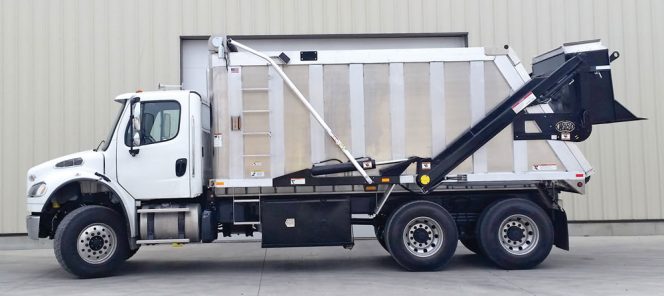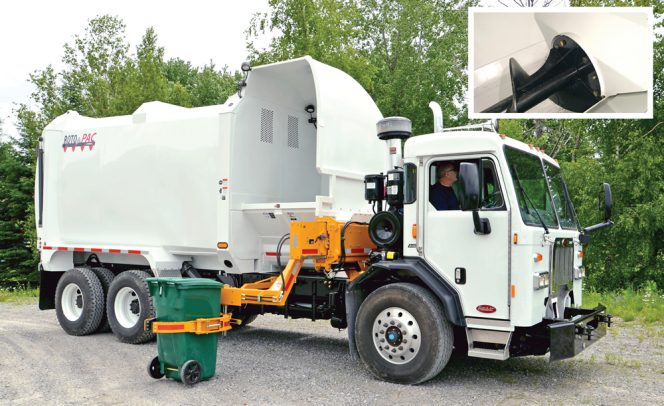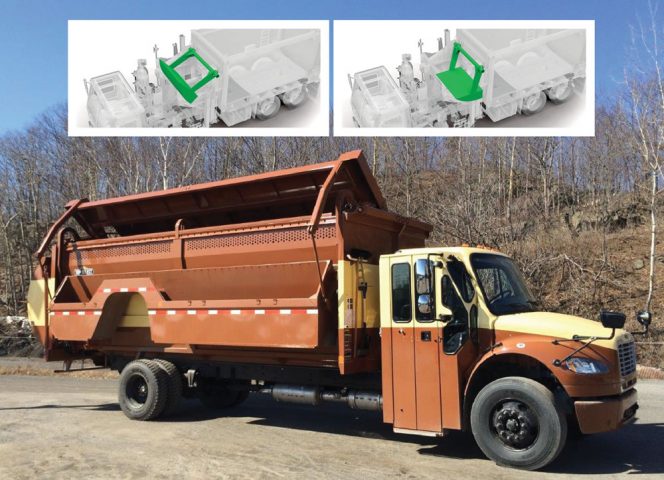Manufacturers are responding to the increased demand for vehicles that can service commercial and residential source separated organics collection.
Barbara Hesselgrave
BioCycle February 2017
Growth in food waste diversion programs has sparked innovation in the waste vehicle manufacturing sector. One clearly needed innovation was making the truck bodies leak-proof, given the high moisture content of food waste. Another was building more muscular lifting arms due to the weight of containers filled with food waste.

Brown Industrial’s food waste truck redesigns focused on three components: no conventional packing blades, welded leak-proof seams and robust lifting.
The redesigns focused on three components: No conventional packing blades, welded leak-proof seams and robust lifting. “With the latest state and municipal regulations that mandate separate collection of organics and food waste, we’re now meeting market need for vehicles to do this specific job,” he adds.
Harry Cohen, CEO of Natural Upcycling Services in Linwood, New York, was looking to start an organics collection program. “I went to Brown Industrial and described what we needed — something smaller for a regional organics operation, rather than the typical larger trash vehicles,” says Cohen. Natural Upcycling bought five, 15- foot long, 10-foot high custom made trucks. “They look like a dump truck but can haul 10 tons of organic waste before it’s full,” he adds. “With no push blade and waterproof welded seams — and you can have a lot of water — the waste is totally contained. This is a huge issue as we can’t have leaking when we are serving the food producer, grocery and restaurant customers.”
Natural Upcycling’s trucks are also fitted with tote washing capability. “The built-in power wash can be operated from inside the cab, or the operator can do a side wash by hand to leave them clean,” explains Cohen. “We use regular Dawn® dishwashing liquid and the containers clean up perfectly after unloading the typical 350 pounds of messy, organics.”
Better Maneuvering, Bigger Payload
Conventional packing blades can be problematic when collecting food waste. “With a conventional packing blade, food waste can leak, and also get behind the blade and the sludge gums it up,” explains Phil Allen, Vice President of New Way Trucks in Scranton, Iowa. “It’s also very hard to clean.” To address this challenge, New Way, which Allen says is the third largest manufacturer of conventional waste vehicles, began marketing the ROTO PAC®, a collection vehicle equipped with 24-inch diameter automatic auger developed by Ginove Inc., of Quebec, Canada.

The ROTO-PAC® marketed by New Way has a retractable arm that can extend 12-feet (left) and a rotating auger mounted in the collection hopper (inset) that mixes and shreds organics, freeing up space in the truck body.
ROTO PAC innovator, Christian Lapointe of Ginove, offers the back story to its development. “When we started designing, we knew that developing a niche product specific for food and organics had to be different than the current technology,” he explains. “Standard compaction is a function of back and forth motion and crushing, but what we do is mixing and shredding which reduces the size of the organic waste and frees up more space. After 13 iterations, today’s auger now delivers 30 percent compaction and we can handle an extraordinary payload and weight density in the organics without any spillage.”
Lapointe adds that the auger can only be operated from inside the cab “so it will not engage at all, unless the driver/operator is physically using the joystick inside. Instead of a dual hoist mechanism on the body to raise and lower the customer totes for emptying, the ROTO PAC has a retractable arm that can extend out to 12 feet to pick up the trash bucket. “It’s all very smooth dumping it into the hopper,” notes Lapointe. “And without a compaction blade there are no cylinders, rollers or tracks so the typical maintenance, cleaning, and wear and tear on those types of moving parts simply doesn’t exist on this vehicle.”
With the load and efficiency in pick-up increased, more homes can be serviced in a day than typical side loaders, according to Allen. In addition, the truck’s wheelbase is 20 to 24 inches shorter than a conventional truck, which improves maneuverability in cities with narrow streets. And one added benefit to organics processors, he says: “Because of the rotational action of the auger it performs a shredding, not crushing action, so it will open most film trash bags. This means that everything is loose and can be processed without a debagging recycling operation.”
Split Body Trucks
Since the 1930s, Levis City on the south shore of Quebec City, Canada has been the home of truck manufacturer Labrie, now known as Labrie EnviroQuip Group. Its latest line-up of trash and recycling trucks in its Organics™ division has unique split-body designs to accommodate collection of organics and trash simultaneously. “What we often sell are three different split-body trucks that let the user load regular household garbage on one side, and organic waste on the other,” explains Labrie spokesperson Louis-Charles Lefebvre. “This really improves the efficiency of collection so instead of passing up and down the street multiple times, you can get everything all at once.”

Labrie’s two organics dedicated models have a pendulum packer technology (artist rendering on far right) that continuously packs organics during collection. The collection containers on the side-loading model (right) are side mounted along the length of the truck frame.
“This vehicle can be a single-side or two-sided side collection,” explains Lefebvre. Options include collecting with the side-lifting arm, which requires manual loading, or the automated lifting arm resembling a vertical conveyer belt. These provide collection functionality that range from manual, to semiautomated to totally automated. He adds these trucks are in use across Canada for residential organics collection, including in Quebec City (Quebec), and Barrie, Ontario.
The collection containers on Labrie’s Top Select side-loaders (trucks with a loading bucket lower to the road) are side mounted along the length of the truck frame. It is raised by arms at each end, and then empties into the truck. All of the company’s truck models are compressed natural gas (CNG) ready. The CNG tanks can be frame, back-of-cab, or roof-mounted.
Other Labrie front and side loaders are fitted with rotational augers. These are installed in the collection hopper and extend through the hopper to the end of the truck body and are very effective in both churning up the organic waste and facilitating an easy discharge of the load. Lefebvre notes that end users such as livestock feed manufacturers who use collected organics for animal feed, “appreciate the already semi-processed organic waste destined for their products.”
Barbara Hesselgrave is a Baltimore-based freelance writer specializing in environmental, engineering and conservation sciences.










